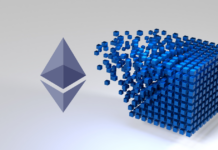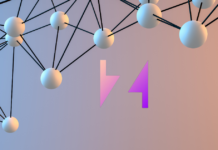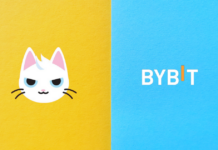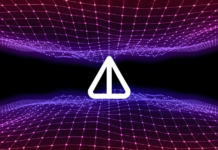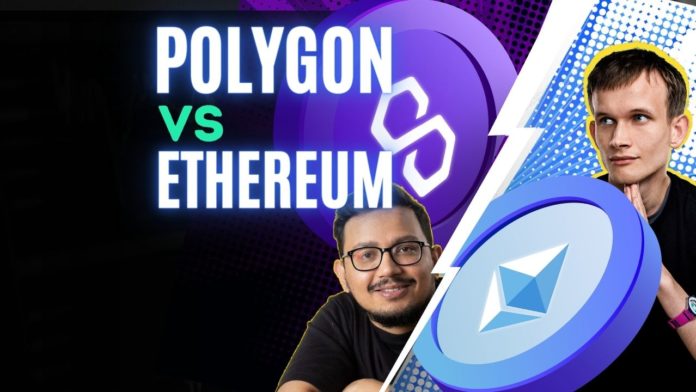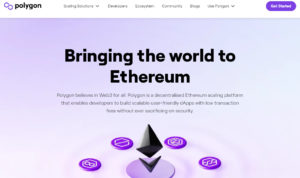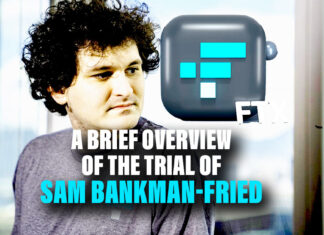The Russian invasion of Ukraine has entered its 3rd day and the fighting continues to intensify. Take a look at this Sberbank, the largest bank in Russia, has limited cash withdrawals for its customers to $20 while Ukrainians are already facing a cash withdrawal limit due to war.
Such unfortunate events emphasize the need for a parallel financial system where we can take our money wherever we want. Thankfully, we have access to such blockchain-backed financial systems now. Therefore, in this article, we are about to compare Ethereum vs Polygon, two of the biggest DeFi chains.
Introduction About Ethereum & Polygon
If you have been in the crypto space for over 6 months, you already know that despite the scalability issues, the Ethereum network is still attracting a lot of development and investment. In fact, Ethereum leads the entire DeFi ecosystem by locking over 56% of TVL. In the last 12 months, the price of ETH has increased its value by 170% and at present it has 415 protocols built on top of it.
On the other hand, Polygon has only 3.3% of the total TVL, and it has 180 protocols built on its networks. But we cannot ignore the fact that Polygon is fairly new in the DeFi space and as a result, MATIC, native Polygon token has grown 4,700% in the last 12 months.
Will Polygon continue to grow and outpace Ethereum, or will Ethereum continue to hold its first mover advantage in the DeFi space? Let’s start with the comparison with Polygon.
1) Polygon
Polygon is a secondary scaling solution for Ethereum blockchain. It lets developers connect their ethereum-compatible smart contracts in Polygon. This blockchain fills the gap with the existing Ethereum’s network, which suffers from slow transactions with high fees without sacrificing on security.
Source: Polygon
Polygon is the “L2 blockchain”. Imagine that Ethereum is the highway, which has its own fee rates and transaction speed. Well, Polygon is the parallel road which gives faster and cheaper transactions.
Also, Polygon is a proof-of-stake (PoS) blockchain that proposed the following improvements to Ethereum’s limitations:
- EVM compatibility is one of the most important features of Polygon because it lets ethereum’s developers launch their dapps, in a couple of clicks, with faster and cheaper transactions.
- Interoperability lets cross-chain protocols exchange information between Polygon and other blockchains.
- Security Modules means that Polygon works as a high-customizability blockchain to enable cross-chain connections without sacrificing security.
Decentralization Level of Polygon
There are so many blockchains now, and each one claims to be truly decentralized. But how can we verify this? Can we measure decentralization? The Nakamoto Coefficient was created to know this in an accurate way.
This indicator represents the number of validators (nodes) that have to log off to decrease the blockchain’s performance. About Polygon , this coefficient was measured in August 2021, which gives as a result 2, considering that the number of validators are 100 in this blockchain, which is a very low level.
1/ Nakamoto coefficient – the minimum number of validators that can collude to shutdown a network
Avalanche – 26 (1,001)
Solana – 18 (849)
THORChain – 10 (37)
BSC – 7 (20)
Terra – 7 (130)
Cosmos – 6 (125)
Fantom – 3 (45)
Polygon – 2 (100)(total # of validators in parentheses)
— larry = $LUNA $OSMO validator (@larry0x) August 3, 2021
Polygon’s Latest Developments & Tokenomics
Polygon is always incentivizing web3 hackathons to make their devs’ community bigger. The prize of the latest hackathon is $250k. Another hackathon occurred in Miami. Also, Polygon is working to develop NFTs in its platform. An example of that is the partnership between Prada and Adidas.
Moreover, Socialstack, a code-free social token platform, is building a community token that will incentivize holders to make positives actions.
On the other hand, at the time of doing this video, Polygon’s native token, MATIC, is in the 17th position of cryptos with the highest market caps. Since its launch in 2017, MATIC has rapidly positioned as the first low-cost and fast alternative to ethereum. Nowadays, the token has accumulated more than $10.4 billion in market cap with $759 million moved in transactions in the last 24 hours.
Moreover, it’s important to say that the max supply is 10 billion tokens. Also, MATIC has the following uses cases:
- Participate in DeFi, gaming, NFT, exchange protocols.
- Transactions fee
- Governance voting
Finally, anyone can buy MATIC practically from any centralized exchange.
Polygon’s Ecosystem & Partnerships
Polygon’s ecosystem has different decentralized applications about DeFi, NFTs, gaming, DAOs dev tools, oracles, and wallets. Here are the most famous ones:
- DeFi: AAVE, Curve Finance, QuickSwap, SushiSwap.
- NFT + Gaming: OpenSea, Atari, Decentraland, Gala Games, Animoca Brands.
- DAO: Blockonomist, El Dorado, BlobDAO, Idavoll network.
- Wallets: Metamask, WalletConnect, Fortmatic, TokenPocket.
- Oracles: Umbrella Network, Certik, Chainlink.
- DEV Tool: Lossless, Validator, Hardhat, The Graph.
On the other hand, there are dApps like GOGOcoin that has partnered with Polygon to develop very rare NFTs that get can get profits up to 45%. Also, Lido finance has partnered with Polygon to let users stake MATIC in a secure and decentralized way.
🥳 In partnership with the awesome @_PolygonStudios, the #CryptoGOGOs #NFTs are back with the superpower to boost your yield by up to 45% 🚀
Earn more rewards here ▶️ https://t.co/b0ju0unupS #NFT #DeFi #PolygonNFT #Polygon #NFTStaking pic.twitter.com/q7kTPtqT5s
— GOGOcoin (@GOGO_coin) January 25, 2022
2) Ethereum
We all know that Ethereum was the blockchain that changed everything in the whole blockchain ecosystem with its launch in 2015. It not only introduced a programmable blockchain where people can develop dApps, but it was the inspiration for many other L1 and L2 blockchains that came later, which ended up having the biggest devs’ community nowadays.
Therefore, the blockchains that came after, used Ethereum’s technology to build optimized networks with better benefits to users.
On the other hand, the Ethereum blockchain let the introduction of new concepts such as “tokens”, “decentralized applications”, “DeFi”, and “NFTs”; this blockchain is the true leader of web3 developments. Here are the Ethereum’s features:
- Token Generator: In the blockchain ecosystem, digital assets are called tokens. You can tokenize any real world asset that cannot be split into more parts. For example, can you sell half of an artwork? No, right? then a piece of art can be converted into a non-fungible token or NFT.
Therefore, with those tokens, you don’t only get a good sell price for it, but you can get royalties every time it’s re-sold. Also, you can use tokens to put it as collateral to get crypto loans.
-
The new free internet: Nowadays, we gain access to ‘free’ internet services by giving our personal information.
However, using Ethereum, you can access any ecosystem’s dApp just with a wallet. No personal info is needed, and you’ll always be in control of your assets.
- A new financial world order: The magic of this blockchain is that it provides a real solution to unbanked people that can send, receive, borrow, lend money worldwide 24/7 without the need of an ID. This is what we call now decentralized finance (DeFi) which is getting new adopters every day.
- Programmable Ethereum introduced this feature in PoW blockchains via smart contracts which let developers have alternatives like:
- Fork code: Re-use code from smart contracts.
- Use compatible languages: Developers don’t need to learn Solidity, the official code language of Ethereum, to develop decentralized applications. They can do it by using JavaScript and other very well-known languages.
At this point, Ethereum has more features than Polygon for now, but this can change in the future.
Decentralization Level of Ethereum
We know that a decentralized blockchain is the one where its information is recorded in nodes, or validators, placed in many parts of the world. So, the more nodes, the more decentralized the blockchain will be, but for comparison purposes it is more appropriate to use this indicator.
In the case of Ethereum, Vitalik Buterin measured this indicator on Dec 2020, and it got between 25 and 34, considering that At that moment, Ethereum had 7400 nodes. At this point, Ethereum wins because this blockchain has a lot more node validators that Polygon right now.
Some updates on decentralization stats since a week ago:
* Participant count over 3k
* Nakamoto coefficient up from 25 to 34
* Herfindahl score down from 0.0164 to 0.0126 (down is good); ~30% more decentralized based on this metricMore participation = more decentralization! pic.twitter.com/F59kSyM8qJ
— vitalik.eth (@VitalikButerin) December 1, 2020
Ethereum’s Latest Developments & Tokenomics
On the other hand, Ethereum has released a set of audited libraries called “ethereum-cryptography 1.0” that will empower more secure projects. Moreover, Ethereum’s blockchain is being used by UNICEF, so startups can develop web3-software solutions.
In this point, Polygon has had more developments in the latest months because this blockchain is growing more in its ecosystem compared to Ethereum.
On the other hand, we all know that ETH is the native token of Ethereum’s blockchain, which created the ERC-20 token standard. Since it was created in 2015, ETH has always ranked as the second crypto with the highest market cap in the market with $335 billion, and it moved $22.2 billion in the last 24 hours.
Despite the fact that ETH has no maximum supply, this token has always been considered, along with bitcoin, as long-term investment assets for being projects that have the most robust technical fundamentals in the entire sector. Therefore, ETH has the following use cases:
- Transactions fees.
- Governance voting
- Participate in DeFi, and DAOs.
- Buy NFTs.
- Buy ENS domain.
- Have a secure digital identity.
Also, buying ETH is very easy because practically every exchange in the world has it available. In conclusion, we consider that MATIC wins this point because despite that the use cases are practically the same, MATIC has a limited max supply and Ethereum doesn’t, which is a strong point for MATIC’s price movement.
Ethereum’s Ecosystem & Latest Partnerships
On the other hand, Ethereum’s ecosystem is one of the biggest ones in the entire ecosystem. Here are the most important ones:
- DeFi: Compound, Oasis, AAVE.Uniswap
- NFT: OpenSea, Rarible, POAP, Audius.
- Gaming:Axie Infinity, Gods Unchained, Dark Forest.
- Metaverse:Decentraland, Cryptovoxels
- Tools:ENS (Ethereum Name Service), Golem, Gitcoin.
It’s important to say that many dapps in both ecosystems aren’t working in an exclusive blockchain. In other words, they are cros–chain dApps. At this point, Ethereum has a bigger ecosystem. However, Polygon’s ecosystem has a lot more potential. For us MATIC wins a point here.
On the other hand, in Ethereum, there haven’t been any partnerships announced in the social media accounts of the Ethereum’s Foundation in the last 3 months. In this point, Polygon has had more partnerships than ethereum in the last months. However, we don’t know how both networks can develop.
Conclusions
After having analyzed the 6 factors, we can conclude that Polygon has much more potential to scale sustainably in the short and long term. But two major questions have been horning in on Polygon’s existence.
- What will happen to Polygon after ETH 2.0?
- Is Polygon’s performance degrading? We have seen a couple of issues there.
We have reserved the answers of these questions for our upcoming articles.
Join us on Telegram to receive free trading signals.
For more cryptocurrency news, check out the Altcoin Buzz YouTube channel.


